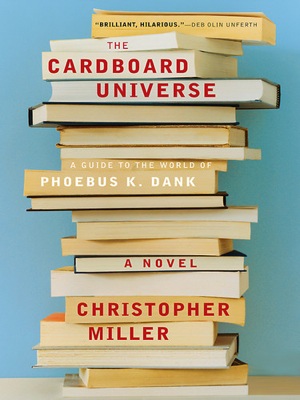
I originally purchase this book as a Christmas gift for my brother. It looked interesting and he is enough of a sci-fi fan that I figured he would appreciate it. When I got it home I skimmed a bit more, started reading the first few pages, and before long I realized I was going to need to find a new Christmas gift for that brother. (Sorry, Ryan! Glad you are enjoying the
Veronica Mars DVDs. You're welcome to borrow this anytime now that I'm finished.)
The Cardboard Universe is a story about a fictional science fiction writer named Phoebus K. Dank. But it isn't a conventional novel, the book is set up like an encyclopedia of his life and work written collaboratively by two critics who knew him in life. It starts with an 'about the authors' blurb, a preface, and a "Dank Chronology" timeline (all fictitious) before going on to an alphabetical listing of entries on major and minor works, family, ex-wives, and other life events (with footnotes) that makes up the entire rest of the novel.
The tone of the dual narrators is an important part of the storytelling. The primary voice is Boswell, a friend of Dank and a committed admirer of his work. Boswell is trying to start the Dank Studies department at the local college and bevies Dank to be one of the greatest writers of our time. He lived with Dank until the author's death (murder, actually, and all this is in the preface so no spoilers). The other narrator is Hirt, a former schoolmate and also former roommate of Dank. Hirt's entries, though, are much harsher and more critical of Dank, both as a writer (a hack) and as a person (a slob). Boswell maintains that Hirt killed Dank in a fit of jealousy but the case was never resolved and Hirt is sending his contributions to the encyclopedia via email from an undisclosed location overseas.
Each entry is written by one of these narrators with the other occasionally interjecting a footnote for additional commentary. The entries range from a few paragraphs to a few pages long, so the novel is very fragmented. From the beginning the book deviates sharply from what a serious encyclopedia would look like. Most of Dank's writing comes from his life- his self doubts, his fantasies, people he knows and events he experiences and then reimagines into a fantastical sci-fi premise, so the narrators constantly speculate on these inspirations and tie various stories back to real-world events. There are continuous digressions into not just the personal life of Dank and the quality of his writing, but also the personal lives of Boswell and Hirt, anecdotes about their current situations, and back and forth snipping at each other. These tangents always start out loosely related to the topic of the entry and then spin off into unrelated territory. Through this technique the rigid structure imposed by the encyclopedia format is broken down and allows for a more conventional narrative story to develop (still quite unconventional, but not nearly as tedious as piecing together a plot from the raw data of a realistic encyclopedia).
For the most part the entries feel almost random since you are getting them in alphabetical order rather than chronological. Also, certain entries refer to future or past entries (cross references are provided in the text). I realize this description makes it sound extremely complex and hard to follow but I want to stress that it is really the exact opposite. Despite all the postmodern indulgences the reading itself comes easy and the story isn't too hard to follow. If anything it spends too much time reinforcing the same points and becomes a bit repetitive but the fragmented nature of a series of entries keeps it varied and makes it easy to pick up and put down.
The aspect of this book that first got me hooked were the entries that encapsulated Dank's many short stories and novels. Each new premise and summarized twist ending kept me engaged to see what else he would come up with. The personalities of the three main characters (Dank, Boswell, and Hirt) quickly emerge through the entries and before long you are invested in the story and interested to find out where it is going. Despite the seemingly arbitrary ordering of entries and the invitation to jump around the text following cross references this is a novel that you want to read straight through. There actually are a few twists and surprises to be revealed in time. I will admit that at over 500 pages it gets a little long and starts to drag a bit in the middle as the seemingly random stories of Dank's laziness, eccentricity and agoraphobia pile up, but it picks up steam toward the end as the real lives of Boswell and Hirt become more interesting.
Dank is obviously inspired by Philip K. Dick, although Dank's fictional lifetime (1952 - 2006) is skewed roughly 25 years from Dick's (1928-82). Also it is clear that the author (the real author, Chris Miller) is a fan of Phillip K. Dick despite the fact that Dank is portrayed as a hack, a slob, and a lazy, somewhat incompetent writer. In fact, Philip K. Dick is even worked into the novel but as a fictional character created by Dank, an imagining of the type of writer he wanted to be. The novel also clearly takes inspiration from Nabokov's
Pale Fire, and is reminiscent of Bolano's
Nazi Literature in the America's. [bonus book recommendation: someone should check out "
Important Artifacts and Personal Property from the Collection of Lenore Doolan and Harold Morris, Including Books, Street Fashion, and Jewelry" which is a work of fiction that attempts to tell the story of a relationship entirely through pictures and accompanying text in the style of an auction catalogue.]
I really enjoyed reading this. It was one of those books that puts you in a good mood knowing that you are on your way home and will have a chance to curl up with it when you get there. I enjoyed each new and inventive story-within-the-story as Dank's oeuvre was reviewed by the collaborators. I want to recommend this book, not just as one of the best of 2009, but as one I think a lot of other people would enjoy and one they might not hear about otherwise.



